 |
Scientific Balloon Circles South Pole on Search for Antimatter
[29 December 2004] - A group of Japanese and American scientists bundled in thick orange jackets, hats, boots and gloves have ventured down to Antarctica on a search for antimatter. With their high-altitude balloon-borne instrument, they are in an exotic land to learn about exotic particles.
|
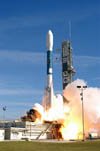 |
NASA Successfully Launches Swift Satellite
[22 November 2004] - NASA's Swift satellite successfully launched on 20 November 2004 aboard a Boeing
Delta 2 rocket at 12:16 p.m. EST from Launch Complex 17A at the
Cape Canaveral Air Force Station, Fla. The satellite will pinpoint the
location of distant yet fleeting explosions that appear to
signal the births of black holes.
|
 |
Massive Merger Of Galaxies Is The Most Powerful On Record
[29 September 2004] - An international team of scientists, led by a NASA-funded researcher, announced they observed a nearby head-on collision of two galaxy clusters. The clusters smashed together thousands of galaxies and trillions of stars. It is one of the most powerful events ever witnessed. Such collisions are second only to the Big Bang in total energy output.
|

|
Scientists Gain Glimpse of Bizarre Matter in a Neutron Star
[21 September 2004] - Scientists have obtained their best measurement yet of the size and contents of a neutron star, an ultra-dense object containing the strangest and rarest matter in the Universe.
|
 |
Scientists Spot Doughnut-Shaped Cloud With a Black Hole Filling
[20 July 2004] - An international team of scientists has found more evidence that massive black holes are surrounded by a doughnut-shaped gas cloud which, depending on our line of sight, blocks the view of the black hole in the center.
|
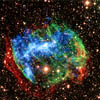 |
Smoking Gun Found for Gamma-Ray Burst in Milky Way
[17 June 2004] - Scientists have uncovered evidence that a gamma-ray burst occurred in our own Galaxy only a few thousand years ago. They found this evidence by studying the supernova remnant, W49B, with the Chandra X-ray Observatory and the Palomar 200-inch telescope. W49B is a barrel-shaped nebula located about 35,000 light years from Earth. The new data reveal bright infrared rings, like hoops around a barrel, and intense X-radiation that together indicate that this may be the first remnant of a gamma-ray burst discovered in the Milky Way.
|
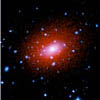 |
Chandra Opens New Line Of Investigation On Dark Energy
[26 May 2004] - Astronomers have detected the mysterious dark energy by
applying a powerful, new method that uses images of galaxy
clusters made by NASA's Chandra X-ray Observatory. The
results trace the transition of the expansion of the universe
from a decelerating phase to an accelerating phase that occured
several billion years ago.
|
 |
Dark Matter May Be Black Hole Pinpoints
[14 May 2004] - Scientists at Stanford University say that dark matter, a mysterious substance that contributes to about 80 percent of the mass of the Universe, might be at least partially in the form of minuscule black holes.
|
 |
World's Most Precise Gyroscopes Ready To Test Einstein Theory
[20 April 2004] - Gravity Probe-B, NASA's spacecraft designed to test two important predictions of Albert Einstein's general theory of relativity, was successfully launched from Vandenberg Air Force Base, Calif., at 12:57 p.m. EDT, April 20, 2004.
|
 |
ESA's Integral Solves Thirty-Year Old Gamma-Ray Mystery
[26 March 2004] - ESA's Integral gamma-ray observatory has resolved the diffuse glow of gamma rays in the center of our Galaxy and has shown that most of it is produced by a hundred individual sources.
|
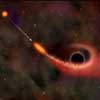 |
Giant Black Hole Rips Apart Unlucky Star In Cosmic Reality Show
[23 February 2004] - Thanks to two orbiting X-ray observatories, astronomers have the first strong evidence of a supermassive black hole ripping apart a star and consuming a portion of it.
|
 |
A Neutron Star Emerges As A Rare Magnetic Emerald
[28 January 2004] - Sometimes astronomers look in the right place at the right time, and
that's just what happened in July 2003.
|
 |
Einstein Makes Extra Dimensions Toe The Line
[17 December 2003] - Scientists say Albert Einstein's principle of the constancy of
the speed of light holds up under extremely tight scrutiny, a
finding that rules out certain theories predicting extra
dimensions and a "frothy" fabric of space.
|
 |
Most Distant X-Ray Jet Yet Discovered Provides Clues To Big Bang
[17 November 2003] - The most distant jet ever observed was discovered in an image of a quasar made by NASA's Chandra X-ray Observatory. Extending more than 100,000 light-years from the supermassive black hole powering the quasar, the jet of high-energy particles provides astronomers with information about the intensity of the cosmic microwave background radiation 12 billion years ago.
|
 |
Chandra "Hears" A Black Hole
[12 September 2003] - NASA's Chandra X-ray Observatory detected sound waves, for the first time, from a super-massive black hole. The "note" is the deepest ever detected from an object in the universe. The tremendous amounts of energy carried by these sound waves may solve a longstanding problem in astrophysics.
|
 |
Pulsars That Rock Space and Time
[02 September 2003] - Envision a bright and beautiful spherical rock, about 10 miles across, packed so tightly and spinning so quickly -- at about 20 percent light speed -- that it actually shakes the fabric of space as if it were a bowl of Jello.
|
 |
Rosetta Stone Decodes Gamma-Ray Burst Mystery
[26 June 2003] - Scientists have pieced together the key elements of a
gamma-ray burst, from star death to dramatic black hole
birth, thanks to a "Rosetta stone" found on March 29, 2003.
|
 |
Burst Behind the Sun Reveals Magnetic Charm of Distant Explosion
[10 June 2003] - Sometimes astronomers plan for years to make a crucial scientific discovery, building a telescope to precise specifications, launching it into space, and conducting a series of long, careful surveys of stars and galaxies.
|
 |
NASA Detects One Of Closest And Brightest Gamma Ray Bursts
[16 May 2003] - The Universe clearly works weekends; delivering one of
the brightest and closest gamma ray bursts yet on Saturday,
March 29, at 6:37 a.m. EST.
|
 |
The Hole Story? New Type of Black Hole Poses Challenges
[10 April 2003] - A half-century ago, black holes were thought of as little more than
bizarre, hypothetical ideas arising from some of Einstein's equations taken
to their extreme. Today, black holes are accepted by astronomers
as a basic component of the Universe.á Under the "standard model" of
black holes, they come in two classes: the stellar and the supermassive.
|
 |
Chandra Sees Shape Of Universe During Formative, Adolescent Years
[03 April 2003] - Scientists using NASA's Chandra X-ray Observatory have taken a snapshot of
the adolescent universe from about five billion years ago when the
familiar web-like structure of galaxy chains and voids first emerged.
|
 |
Race To Gamma Ray Burst Reveals Gigantic Explosion, Death, & Birth
[24 March 2003] - Scientists arriving on the scene of a gamma ray burst,
just moments after the explosion, have witnessed the death
of a gigantic star and the birth of something monstrous in
its place, quite possibly a brand-new, spinning black hole.
|
 |
NASA Releases Stunning Images Of Our Infant Universe
[12 February 2003] - NASA today released the best "baby picture" of the
Universe ever taken; the image contains such stunning detail
that it may be one of the most important scientific results
of recent years.
|
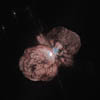 |
Eta Carinae, a Home-Grown Mystery
[28 January 2003] - Even as astronomers probe the farthest edges of the Universe billions of
light years away to unlock its wondrous mysteries, there are still
baffling mysteries right here in our own Milky Way Galaxy.á A big,
beautiful star named Eta Carinae is one such example.á At the American
Astronomical Society meeting in January, scientists presented new data
about this enigmatic star that challenges long-held beliefs.
|
 |
Exotic Innards of a Neutron Star Revealed in a Series of Explosions
[25 November 2002] - Amidst the fury of 28 thermonuclear blasts on the surface of a neutron
star, scientists using the European Space Agency's XMM-Newton X-ray
satellite have obtained a key measurement revealing the nature of matter
inside these enigmatic objects.
|
 |
Chandra Discovers The History Of Black Hole X-Ray Jets
[13 November 2002] - For the first time, astronomers have tracked the life
cycle of X-ray jets from a black hole. A series of images
from NASA's Chandra X-ray Observatory revealed the jets
traveled at near light speed for several years before slowing
down and fading.
|
 |
Europe opens a window onto a violent Universe
[17 October 2002] - On 17 October 2002, the
European Space Agency launched a new observatory set to revolutionize
the branch of astrophysics that seeks to unravel the secrets of the highest-energy,
and therefore the most violent, phenomena in the Universe. This comes
20 years after the end of ESA's COS-B mission, which produced a complete
map of the sky in the high-energy gamma-ray waveband.
|
 |
Riccardo Giacconi Awarded Nobel Prize For Pioneering Work In X-Ray Astronomy
[10 October 2002] - More than 100 years ago, the first Nobel Prize in physics
was awarded to Wilhelm Röntgen for his discovery of X-rays.
This week, Riccardo Giacconi was recognized with a share
in the Nobel Prize in physics for his pioneering work in
X-ray astronomy.
|
 |
Space Movie Reveals Shocking Secrets of the Crab Pulsar
[20 September 2002] - Just when it seemed the summer movie season had ended,
two of NASA's Great Observatories have produced their own
action movie. Multiple observations made over several months
with NASA's Chandra X-ray Observatory and the Hubble Space
Telescope captured the spectacle of matter and antimatter
propelled to nearly the speed of light by the Crab pulsar.
|
 |
Scientists Observe Light Fighting to Escape
Black Hole's Pull
[02 July 2002] - Scientists have found new evidence that light emanating from near a black hole loses energy climbing out of a gravitational well created by the black hole, a key prediction of Einstein's theory of general relativity.
|
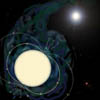 |
Going, going, almost gone: Pulsar whittles away stellar companion to planet-size
[30 May 2002] - Scientists at the Massachusetts Institute of Technology have found a pulsar in a binary star system that has all but completely whittled away its companion star, leaving this companion only about 10 times more massive than Jupiter.
|
 |
Retired Quasars Live on to Generate the Fastest, Most Energetic Cosmic Rays
[22 April 2002] - They are old but not forgotten. Nearby "retired" quasar galaxies, billions of years past their glory days as the brightest beacons in the Universe, may be the current source of rare, high-energy cosmic rays, the fastest-moving bits of matter known and whose origin has been a long-standing mystery, according to scientists at NASA and Princeton University.
|
 |
Scientists Detect First Afterglow of Short Gamma-Ray Bursts
[01 March 2002] - In the powerful realm of gamma-ray bursts, scientists say they have detected for the first time a lingering afterglow of the shortest types of bursts, which themselves disappear within a second.
|
 |
Coming to a Theater Near You -- The Stormy Sun
[12 February 2002] - Lights, camera, action! With the launch of NASA's High Energy Solar Spectroscopic Imager, or HESSI, scientists will capture high-fidelity color movies of the most powerful events in the Solar System -- solar flares.
|
 |
"Local" Gamma-Ray Bursts Are Newest Pieces of Puzzle
[28 January 2002] - Don't look now, but some gamma-ray bursts may be closer than you think. Although scientists have believed for some time that most gamma-ray bursts originate from the farthest reaches of the Universe, a NASA Goddard scientist has discovered about 100 of them that are quite "local," within 325 million light years from Earth.
|
 |
A TIGER in Antarctica
[30 November 2001] - High above the chilly continent of Antarctica, far beyond the sight of even the sharpest-eyed penguins, scientists are flying a massive balloon with an instrument that catches tiny bits of matter that have traveled across much of the Milky Way galaxy, perhaps strewn by ancient star explosions.
|
 |
Energy "Escapes" Black Holes to Heat Nearby Space
[24 October 2001] - Have you ever seen an old-fashioned locomotive chugging into a railway station with its powerful wheels screeching to a halt, sending out sparks and heating the rails?
|
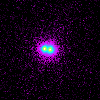 |
Mysterious "Twofaced" Star Explained, Scientists Say
[25 September 2001] - There's a simple reason why a curious neutron star in the M15 globular star cluster has shown two faces over the years, beaming an X-ray portrait as perplexing as Mona Lisa's smile. The reason: That's not one star system, but two.
|
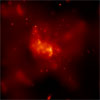 |
Chandra Catches Milky Way Monster Snacking
[10 September 2001] - For the first time astronomers have detected material
being consumed by the supermassive black hole in our own
backyard. A violent, rapid X-ray flare,
captured by NASA's
Chandra X-ray Observatory, has been observed from the
direction of the supermassive black hole that resides at the
center of our Milky Way Galaxy.
|
 |
Astronomers Go Behind the Milky Way to Solve X-ray Mystery
[10 August 2001] - Astronomers using the Chandra X-ray Observatory have peered behind
the Milky Way galaxy for the first time, through layers of dust and
gas that stretch out for 30,000 light years. They discovered 36
bright, distant galaxies lurking back there, and they found that the
source of the Milky Way's X-ray emission is hot, diffuse gas.
|
 |
Chandra Detects Halo of Hot Gas Around Milky Way-Like Galaxy
[1 August 2001] - The first unambiguous evidence for a giant halo of hot
gas around a nearby, spiral galaxy much like our own Milky
Way was found by astronomers using NASA's Chandra X-ray
Observatory. This discovery may lead to a better
understanding of our own Galaxy, as well the structure and
evolution of galaxies in general.
|
 |
MAP Launches Successfully
[3 July 2001] - The MAP satellite is off and running on its journey to the beginning of time. NASA's Microwave Anisotropy Probe launched successfully on Saturday, June 30, at 3:46 p.m. EDT from Cape Canaveral aboard a Delta II rocket. The satellite will study the first light of the Universe -- the afterglow of the Big Bang -- from an era long before the first stars and galaxies appeared.
|
 |
New Type of Black Hole May Turn Starburst Galaxies Inside Out
[5 June 2001] - Starburst galaxies -- those distant gems set aglow in a colorful
lifecycle of star birth, death and renewal -- may be the stepping
stone to a far brighter phenomenon: a quasar-type galaxy with a
supermassive black hole at its core.
|
 |
Black Holes Make Take Space For A Spin
[30 April 2001] - As if black holes weren't menacing enough, astronomers now have observational evidence that at least some of them spin about like whirlpools, wrapping up the fabric of space with them.
|
 |
The Grand ASCA Mission
[20 March 2001] - What goes up, must come down. ASCA, a workhorse of an X-ray observatory that provided astronomers their first real glimpse of black holes, is no exception.
|
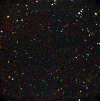 |
Deepest X-rays Ever Reveal Universe Teeming With Black Holes
[14 March 2001] - For the first time, astronomers believe they have proof
black holes of all sizes once ruled the Universe. NASA's
Chandra X-ray Observatory provided the deepest X-ray images
ever recorded, and those pictures deliver a novel look at the
past 12 billion years of black holes.
|
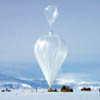 |
Classy Antarctic Balloon Captures the Earliest Light of the Universe
[01 March 2001] - TopHat, an innovative hat-shaped astronomy experiment that sits on top of a balloon, circled around the frozen continent at 120,000 feet for nearly two weeks in January, collecting light from the cosmic microwave background radiation.
|
 |
Not Seeing is Believing When it Comes to Event Horizon Evidence
[01 February 2001] - NASA's two great observatories, the Hubble Space Telescope and the Chandra X-ray Observatory, have independently provided what could be the best direct evidence yet for the existence of an event horizon, the defining feature of a black hole and one of the most bizarre astrophysical concepts in nature.
|
 |
Chandra Links Pulsar to Historic Supernova
[19 January 2001] - New evidence from NASA's Chandra X-ray Observatory suggests that a
known pulsar is the present-day counterpart to a supernova that exploded in
386 AD, a stellar explosion witnessed by Chinese astronomers. If
confirmed, this will be only the second known pulsar to be clearly
associated with a historic event.
|
 |
Students Find Elusive Pulsar
[3 January 2001] - Three high school students won first place in the national Siemens-Westinghouse Science and Technology Competition for their discovery of a spinning neutron star, or pulsar. Their unique access to data from NASA's Chandra X-ray Observatory X-ray Observatory allowed them to prove the existence of a pulsar that professionals had not been able to positively identify, despite extensive studies.
|
 |
Three Hours of Unimaginable Neutron Star Fury
[21 November 2000] - As if daily billion-degree, helium-fueled nuclear explosions on neutron stars releasing more energy in 10 seconds than the Sun does in a week weren't fantastic enough, brace yourself for one blast far more powerful and lasting far longer.
|
 |
Dishwasher-shaped Satellite to Catch Gamma-Ray Bursts
[10 October 2000] - Gamma-ray bursts are explosions that represent the greatest release of energy in the Universe other than the Big Bang. Satellites detect several of these bursts a day, and scientists do not know what causes them.
|
 |
Astronomers Find the Youngest Pulsar Yet
[11 September 2000] - Astronomers at Columbia University used the Rossi X-ray Timing Explorer to find the youngest pulsar yet -- a hot, spinning, highly-magnetized infant no more than ten miles across, born in a massive star explosion about 700 years ago.
|
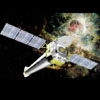 |
X-Ray Observatory Marks First Anniversary
[28 August 2000] - NASA's Chandra X-ray Observatory celebrates its initial year in orbit with an impressive list of firsts. Through Chandra's unique X-ray vision, scientists have seen for the first time the full impact of a blast wave from an exploding star, a flare from a brown dwarf, and a small galaxy being cannibalized by a larger one.
|
 |
Chandra Captures Flare From Brown Dwarf
[7 August 2000] - Brown dwarfs are objects smaller than our sun and most other stars, but larger than gas giant planets like Jupiter and Saturn. Unlike stars, brown dwarfs have too little mass to sustain nuclear reactions in their cores, so they're very dim - less than a tenth of a percent as luminous as the sun. Their primary source of energy is the release of gravitational energy as they slowly contract. Brown dwarfs intrigue many astronomers because they are poorly understood and probably a very common class of objects. But because they are cool, dim objects, they rarely provide much for high-energy astronomers to observe.
|
 |
Cuddling Up in a Quilt of Gamma-ray Stars
[19 July 2000] - The Compton Gamma Ray Observatory may be gone, but its memory lives on --
in a quilt museum in Harrisonburg, Virginia. Unbeknownst to Compton
astronomers, a retired couple in rural Virginia took two gamma-ray
images that their son received from NASA way back in 1993 and turned
them into spectacular quilts.
|
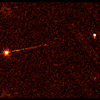 |
Chandra Reveals Cosmic 'Hot Spot'
[12 June 2000] - When you look at the image at left, what do you see? Two bright spots and a streak? That's exactly what it is, but it's also much more than that. The image, captured by NASA's Chandra X-ray Observatory, shows a spectacular jet of x-rays streaking across hundreds of thousands of light years. The jet is powered by a giant black hole in the center of the galaxy, Pictor A. The stream of radiation ends in a brilliant x-ray hot spot.
|
 |
Compton Gamma Ray Returns Safely to Earth
[5 June 2000] - NASA's Compton Gamma Ray Observatory re-entered the Earth's atmosphere at approximately 2:10 a.m. EDT on June 4, according to calculations made by controllers at NASA's Goddard Space Flight Center, Greenbelt, Md., in coordination with the U.S. Space Command's Control Center.
|
 |
Compton Gamma Ray Observatory De-Orbit Status
[2 June 2000] - After nine years of producing spectacular science that brought the field
of gamma-ray astronomy to its maturity, the Compton Gamma-Ray Observatory
will return to earth in a controlled reentry over the Pacific Ocean on
June 4.
|
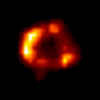 |
Chandra Views a Supernova Remnant in the Making
[12 May 2000] - Images made by NASA's
Chandra X-ray Observatory
show for the first time the full impact of the blast
wave from Supernova 1987A (SN1987A). The observations are the
first time that X-rays from a shock wave have been imaged
at such an early stage of a supernova explosion. Astronomers
are thrilled to see these images showing the progress of
a supernova remnant in the making.
|
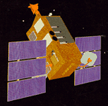 |
MIT Animation Reveals Violent X-ray Sky
[5 May 2000] - If you could view the night sky with X-ray sensitive eyes, you would see a
turbulent panorama of dying stars, active quasars and the extreme temperatures
produced by matter falling into massive black holes at mind-boggling speeds.
An animated video (see below) released by researchers
at the Massachusetts Institute of Technology reveals this changing and turbulent
X-ray sky during the past four years.
|
 |
Colliding Galaxies Create Cosmic "Cold Front"
[10 April 2000] - When you think of a cold front, you probably imagine a temperature
drop of five or ten degrees. Astronomers and astrophysicists deal with a very different scale. Fifty million degrees may not seem cold to you. But compared to 70 or 100 million degrees, it's quite chilly. Scientist recently mapped a region of those relatively cool temperatures buried inside a large region of
colliding galaxies and 70 to 100 million degree gases. It's the first time the
pressure fronts in the system have been mapped in detail.
|
 |
Compton Gamma Ray Observatory to be Retired
[27 March 2000] - NASA's extremely productive and long-lived Compton Gamma-Ray Observatory (CGRO) will end its mission in late May as it is brought back to Earth under a controlled re-entry plan. In December 1999 CGRO suffered the loss of one of it's three gyroscopes which are used to control the orientation of the satellite. NASA decided that the safest course of action was to bring the satellite down using the two remaining gyros. CGRO exceeded its expected mission lifetime by four years and completely changed ideas on the most important unsolved puzzles in astrophysics.
|
 |
Hidden Gamma Ray Sources to be Exposed
[14 March 2000] - The universe is a violent place. Stars explode. Galaxies collide. Gas and dust spin around black holes at incredible velocities until the black holes devour it all. Recent space telescope missions have given scientists a glimpse into the nature of these violent events and energetic objects. "GLAST" will give them a much better look.
|
 |
The Universe Lights Up on Beethoven's Birthday
[30 December 1999] - Ludwig van Beethoven would have been impressed. On December 16, the
229th anniversary of the musician's birth, the Universe lit up in
gamma rays that, for a few seconds, outshone the entire sky.
|
 |
European Space Agency Launches XMM
[10 December 1999] - In July 1999, NASA launched an extraordinary X-ray telescope named
Chandra. At a distance one-third of the way to the moon, the telescope's
deep, lonely orbit gives it an unimpeded view of distant exploding stars
and clusters of galaxies.
|
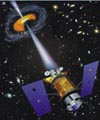 |
SWIFT Satellite to Catch the Most Powerful Flashes of Light Known in the Universe
[26 October 1999] - Once or twice a day, without warning, there are brief flashes of
highly energetic light that momentarily outshine the rest of the
universe. NASA has chosen to develop a mission that will be capable of
capturing information about these unpredictable bursts of gamma-rays.
|
 |
Discovery of Small X-ray Ring around Crab Pulsar Solves Old Mystery
[15 October 1999] - Recent images obtained with the Chandra X-ray Observatory have
uncovered part of the secrets of the Crab Nebula by revealing a bright
small ring around its center. Scientists had long searched for the
missing link between the central
pulsar and the nebula
and it would seem that their quest is now over.
|
 |
Astronomers Find First Direct Evidence Linking Black Holes and Supernovae
[21 September 1999] - Astronomers believe that black holes are the evolutionary endpoints of
stars at least 10 to 15 times as massive as the Sun. If such a star
undergoes a violent
supernova explosion, the core
of the star it leaves behind may gravitationally collapse in on
itself, creating a
singularity - an entity with
zero volume and infinite
density - a black hole.
|
 |
Chandra Observatory Launch Lights Up the Night Sky
[23 July 1999] - X-ray astronomy moved into the 21st century today with the launch of the
Chandra X-ray Observatory (CXO). Shortly before 12:30 a.m. EDT, the Space
Shuttle Columbia blasted off from the Kennedy Space Center in Florida.
Under the command of Lt. Colonel Eileen Collins, the shuttle will begin to
deploy CXO later today in their 5 day mission.
|
 |
Brighter than an Exploding Star, It's a Hypernova!
[20 May 1999] - In a galaxy not so far away - only 25 million light-years - astronomers
have found what looks like are the remnants of strange celestial explosions
called hypernovae. "Hypernovae are possibly the most powerful explosions in
our Universe since the Big Bang," said Q. Daniel Wang, an astrophysicist at
Northwestern University. Such explosions are more powerful than supernovae,
the spectacular death gasps of stars some 5-10 times more massive than our
Sun. In fact, hypernovae may produce some 100 times more energy than
supernovae. But what are these explosions and what causes them? Astronomers
are not sure at this point. It is hoped that the discovery of these two
suspected hypernova remnants, called MF83 and NGC5471B, located in the
nearby spiral galaxy M101 will allow astrophysicists to infer their true
nature.
|
 |
STS-93 Readies for Lift-Off with Chandra Observatory
[28 January 1999] - The next Shuttle flight will occur sometime in the Spring of 1999,
and carry in its payload bay NASA's next X-ray astronomy satellite.
The exact date for launch is not yet determined due to a recent
delay, but it will occur no earlier than April 8. This flight will
also be the first time a woman astronaut, US Air Force Colonel
Eileen Collins, will serve as the Flight Commander. STS-93 will
be
the 94th Space Shuttle flight, and the 26th flight for the orbiter
Columbia.
|
 |
Yes, Virginia, There is a Magnetar!
[26 October 1998] - A star, located 40,000 light-years from Earth, is generating the
most intense magnetic field yet observed in the Universe, according to an
international team of astronomers led by scientists at NASA's Marshall
Space Flight Center in Huntsville, AL.
The discovery confirms the existence of a special class of neutron stars
dubbed "magnetars." A neutron star is a burned-out star roughly equal
in mass to the Sun that has collapsed through gravitational forces to be
only about 10 miles across. A magnetar has a magnetic field estimated to
be one thousand trillion times the strength of Earth's magnetic field.
Magnetars have a magnetic field that is about 100 times stronger than the
typical neutron star.
|
 |
"Old Faithful" Black Hole Provides Insight into Jet Formation
[17 August 1998] - Scientists observing a disk of matter surrounding a black
hole in our Galaxy have discovered that the disk is periodically
disrupted and hurled outward in opposite directions from the black
hole, in jets moving at nearly the speed of light. The black hole
replenishes the disk by pulling hot gas from the surface of a
nearby "companion" star, and then undergoes another disruption,
repeating the sequence at half-hour intervals.
|
 |
Astronomers Detect Most Powerful Explosion Since Big Bang
[18 May 1998] - The energy released in a cosmic gamma-ray burst detected in
December 1997 is the most energy ever detected from an explosion in the
Universe, perhaps making it the most powerful explosion since the creation of
the Universe in the Big Bang.
|
 |
NASA Announces Contest to Name X-Ray Observatory
[17 April 1998] - NASA is searching for a new name for the
Advanced X-ray Astrophysics Facility (AXAF),
currently scheduled for launch Dec.
3, 1998, from the Space Shuttle Columbia. AXAF is the third of
NASA's Great Observatories, after the
Hubble Space Telescope and
the Compton Gamma
Ray Observatory. Once in orbit around Earth, it
will explore hot, turbulent regions in the universe where X-rays
are produced.
|
 |
Newly Discovered Pulsar Spins its Way into History
[25 Feb 1998] - Astronomers have discovered a neutron star spinning at a rate of over 60
times a second! The star, a pulsar believed to have formed in a supernova
explosion some five thousand years ago, is spinning faster than most
scientists believed possible for such an object. The pulsar was found by a
team of astronomers including Frank Marshall, William Zhang, and Eric
Gotthelf from NASA's Goddard Space Flight Center, along with John
Middleditch from Los Alamos National Laboratory. "The pulsar is spinning
twice as fast as any young pulsar that we have seen before," said
Marshall. "To put it in perspective, this pulsar is spinning more than 6
million times as rapid as the Earth."
|
 |
Mirror, Mirror...
[14 Dec 1997] - A new type of X-ray mirror that allows images to be made from higher energy
radiation than ever before has recently completed testing at NASA's Goddard
Space Flight Center, Greenbelt, MD.
|
 |
The Yell of a Black Hole
[04 Dec 1997] - How fast are
black holes at the centers of distant galaxies swallowing the matter around them? Using
observations from the Japanese/NASA Advanced Satellite for Cosmology and
Astrophysics (ASCA), Paul Nandra, Richard Mushotzky, and their
research team have begun to shed some light on this question.
|
 |
Einstein Passes Another Test
[07 Nov 1997] - Astronomers using NASA's Rossi X-ray Timing Explorer (RXTE)
spacecraft reported on November 6 that they have observed a black hole
that is literally dragging space and time around itself as it
rotates. This bizarre effect, called "frame dragging," is the
first evidence to support a prediction made in 1918 using
Einstein's Theory of Theory of Relativity.
|
 |
Future Mission Gets Stellar Name
[22 Oct 1997] - The Next Generation X-ray Observatory called the High Throughput X-ray
Spectroscopy (HTXS) mission has been renamed the Constellation Mission.
|
 |
A New Dark Matter Discovery
[23 July 1997] - X-ray observations by of the celestial object MG2026+112 have given
scientists a new puzzle to solve....and great clues to help them do it!
|
 |
The Milky Way Blows Bubbles ?!
[07 May 1997] - Astronomers using the NASA's Compton Gamma-Ray Observatory (CGRO) satellite to
map the distribution of antimatter in the Milky Way Galaxy were
surprised to find what appears to be a large antimatter
bubble being blown upward from the center of our Galaxy.
|
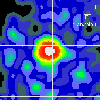 |
Look, There in the Sky! It's a Gamma-Ray Burster?
[27 Mar 1997] - What exactly is the source of a gamma-ray burst? Since their
discovery in the early 1970s, nobody has been able to explain the cause of the
mysterious flash of gamma-rays called a gamma-ray burst that seems to come
from a random direction on the sky. Worse yet, it is even unclear whether
these high-energy explosions originate in our own Galaxy or in distant
galaxies across the Universe. Now, all of that may have changed!
|
 |
Reboosting the Compton Gamma-Ray Observatory
[18 Feb 1997] - The Compton Gamma-Ray Observatory (CGRO) has been in Earth orbit for nearly
six years now. In that time, observations from its 4-instrument complement
have greatly expanded our understanding of the most energetic objects in the
Universe.
|
 |
First All-Sky Maps of the ROSAT Soft X-ray Diffuse Background Survey
[2 Dec 1996] - The first all-sky maps from the ROSAT survey of the diffuse X-ray
background have been released by the Max Planck Institute for
Extraterrestrial Physics in Garching, Germany.
|
 |
Launch Problem Thwarts New Missions
[14 Nov 1996] - The November 4 launch of two new high energy astrophysics missions, SAC-B
and HETE, ended in disappointment when the third stage of the launch vehicle
failed to separate. The two spacecraft and the rocket stage remained locked
in a position which prevented HETE's solar panels from opening, and kept
SAC-B's solar panels from pointing properly at the Sun. Unable to generate
power to communicate with the Earth, run their instruments and recharge their
batteries, the spacecraft will not be able to fulfill their scientific
missions.
|
 |
The sky is no limit in the space program
[28 Oct 1996] - By Hillary Rodham Clinton
Reproduced from the 13 October 1996 Annapolis CapitalWhen I was 14, I dreamed of becoming an astronaut. Inspired by Alan Shephard's
pioneering 15-minute trip into space, I wrote NASA to find out what I needed to
do to see the stars up close. The space agency thanked me for my interest
but said that women were not being considered for the job.
|
 |
Beppo -- the Satellite, the Science, and the Man
[19 Sep 1996] - BeppoSAX is the first X-ray mission (and, of the coming near-future
satellites, the only mission) which has the capability of observing sources
over more than three decades of energy - from 0.1 to 200 keV - with a
relatively large area, a good
energy
resolution, and
imaging
capabilities (resolution of about 1 arcminute) in the range of
0.1 - 10 keV.
|
 |
Twinkle, twinkle (really fast!) little star!
[12 Jul 1996] - The Rossi X-ray Timing Explorer (RXTE) has discovered neutron stars that emit streams of X-rays pulsing over 1,000 times a second. The pulses are not strictly periodic, but vary slightly from cycle to cycle. Astronomers call them "quasi-periodic oscillations (QPOs)". This just means that the pulses are almost, but not quite, periodic.
|
 |
The Bursting Pulsar (GRO J1744-28)
[10 Jun 1996] - The Bursting Pulsar was discovered in December 1995 by the Burst and Transient Source Experiment (BATSE) on the Compton Gamma-Ray Observatory. BATSE discovered energetic outbursts of high energy X-rays and low energy gamma-rays being emitted every few minutes from this object located near the galactic center. This object, which came to be known as the Bursting Pulsar, brightened to become the brightest X-ray source in the sky in February before steadily fading in April and May.
|
 |
First X-rays From a Comet Discovered!
[15 Apr 1996] - A team of U.S. and German astrophysicists have made the
first ever detection of
X-rays coming from a comet. Their discovery of a strong
radiation signal
-- about 100 times brighter than even the most optimistic predictions -- was
made March 27, 1996, during observations of
Comet Hyakutake using Germany's orbiting
ROSAT satellite.
|
